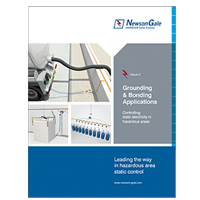The International Electrotechnical Commission has published a new Technical Specification called IEC 60079-32-1: “Explosive atmospheres - Part 32-1: Electrostatic hazards - Guidance”, which is designed to limit fires and explosions caused by electrical malfunctions within hazardous areas.
It is the first of two documents under the “60079-32” designation and covers a broad range of process scenarios that can
lead to the generation of electrostatic charges, provides examples of what measures can be taken to reduce charge generation and accumulation and outlines how process equipment should be grounded and bonded.
The second part, IEC 60079-32-2, is entitled “Electrostatics hazards – Tests” and outlines test methods to determine factors like surface resistance, earth leakage resistance, powder resistivity, liquid conductivity, capacitance and the incendivity of electrostatic discharges.
Overview of the Technical Specification:
The Technical Specification is sub-divided into “clauses” that highlight the electrostatic hazards associated with various categories:
1) The handling of solids.
2) The storage and handling of liquids.
3) The handling of gases and vapours.
4) The storage and handling of powders.
5) The storage and handling of explosives.
6) Electrostatic problems caused by people.
7) Avoidance of electrostatic shock.
8) Earthing and bonding of plant and machinery.
There are several Annexes that provide informative material, such as a description of the various types and assessment of electrostatic discharges within potentially flammable and combustible atmospheres.
The design and monitoring of grounding systems: This section addresses the design and monitoring of systems dedicated to grounding permanent and portable plant equipment. Permanently installed plant equipment like reactors and pumps will most likely be grounded via the electrical grounding system for the plant.
The section for portable conductive equipment recommends that temporary connections using bolts or “pressure-type” clamps are capable of penetrating protective coatings, rust or product deposits that are typically present on the surface of such equipment, e.g. metal drums. It states that pressure type clamps should be capable of establishing a connection resistance of less than 10 Ohms to the base metal of the conductive equipment.
Type C FIBC:
This section describes which hazardous zones the four bag types (A,B,C,D) are suitable for use in. The “zones” are based on the IEC method of hazardous area zoning classification which have been adopted in ATEX legislated countries, the U.S. NEC 505 & 506 and the Canadian CEC. It specifies the types of liners (L1, L2, L3) and FIBC bag type combinations that may or may not be used in hazardous areas. This section heavily references IEC 61340-4-4: “Electrostatics – Part 4-4: Standard test methods for specific applications – Electrostatic classification of flexible intermediate bulk containers (FIBC)” which specifies the construction, testing and labelling criteria for Type A,B,C,D FIBC bags.
Under the requirements of this standard, Type C bags must be grounded and for those manufacturing or using Type C bags the resistance from any part of the bag to a groundable point on the bag shall be less than 10 Meg-ohm. This is a change from CLC/TR: 50404 which recommended a maximum resistance of 100 Meg-ohm.
Road Tankers and Vacuum:
Included in the Technical Specification is guidance regarding the grounding of road tankers as well as precautionary measures for the grounding of vacuum trucks.
Personnel grounding, flooring and footwear:
Clause 11 provides guidance on minimising the risk of static electricity accumulating on people and describes various scenarios where this occurs, along with methods to dissipate charge off people.
Conclusion:
Technical Specification IEC 60079-32-1 is probably the most comprehensive guidance produced on avoiding the hazards of static electricity to date. This article provides a brief overview and it is recommended that readers obtain a copy of the full Technical Specification.
For more information visit:
www.newson-gale.co.uk.



